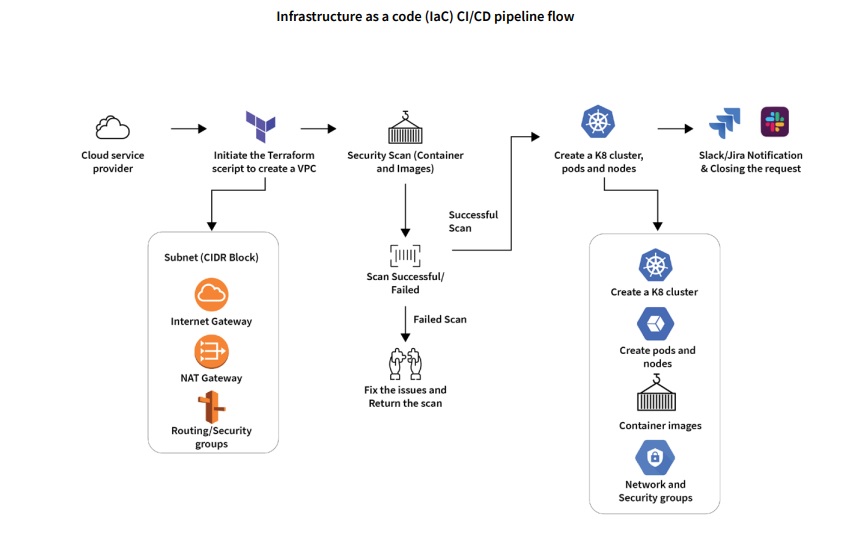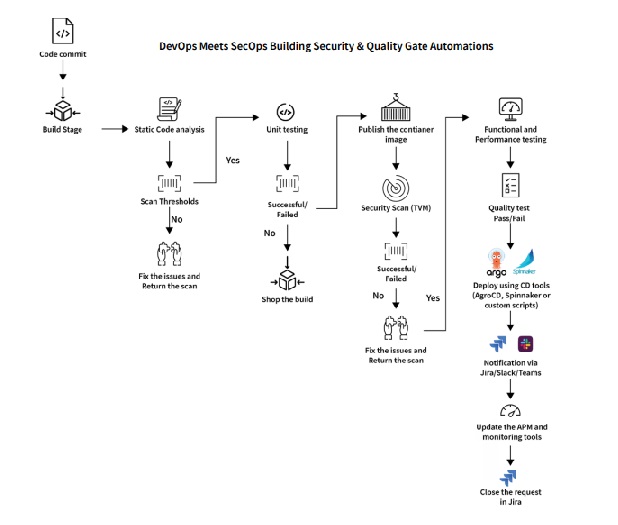OutSystems announced the general availability (GA) of Mentor on OutSystems Developer Cloud (ODC).
In the cloud world, containers are the centerpoint of a growing majority of deployments. By providing compartmentalization of workloads and the ability to run "serverless," containers can speed up and secure deployments and create flexibility unreachable by old style application servers. While a variety of tools have been developed to meet this need, none are as impactful to the industry as Kubernetes. It has emerged as the de facto container orchestration tool for many companies.
Kubernetes alone is a powerful framework, but relies entirely on proper configurations to achieve the desired results. Kubernetes facilitates the ability to automate the DevOps CI/CD pipeline but alone can be unwieldy.
Key Challenges With Kuberenetes:
■ No native containerization framework support to easily migrate existing workloads from VMs to Kubernetes
■ High dependency on the underlying platforms and architecture slows down deployments on on-premises and hybrid clouds
■ Security is an afterthought making the deployment vulnerable to supply chain attacks (for example, Sunburst)
No-code DevOps Orchestration and Kubernetes together can create fully-managed Infrastructure-as-Code CI/CD (Continuous Integration and Continuous deployment) pipelines for container-based applications.
This approach provides the best of the both worlds, taking advantage of Kubernetes' open-source system to manage your containerized applications, while techniques such as toolchain automation, declarative CI/CD pipelines, and end-to-end visibility can enable developers and engineers to build, secure, validate, and deploy applications using drag-and-drop tools and build a no-code pipeline in minutes.
Key Benefits:
■ Simplify containerization efforts when adopting the Kubernetes framework
■ Achieve continuous orchestration across on-premises or hybrid clouds
■ Accelerate CI/CD with automated quality and security checkpoints even in multi-vendor deployments
■ Identify gaps and improve observability with unified visibility across the entire CI/CD
Define and Deploy Infrastructure as Code
As discussed previously, a big advantage of Kubernetes framework is that anything that can be defined, can be automated. But this must all be built and configured before Kubernetes can take over stateful control. This can present a challenge for users, depending on their skills and knowledge of Kubernetes. For example, in order to automate code deployments, a load balancer must be configured. As well, a successful automation must contain security gates and quality checkpoints that halt the deployment and rollback if unmet.
Building this by hand in Kubernetes can be a daunting task, however orchestration tools make this go from challenging to straightforward. Across any cloud or hybrid platform, you can easily define your clusters, nodes, pods, and containers while implementing security groups and checks/scans using continuous orchestration and Terraform templates.
An orchestration framework enables DevOps and Cloud engineers to add validation, thresholds, gates, approvals and add additional steps in the workflow without writing custom code. Aggregating software delivery analytics with observability and a singular view across your CI/CD process is critical. This also helps create visibility into activity logs across various steps for visibility across the entire CI/CD pipeline.

From Old to New Migrating VM Workloads to Containers
As previously discussed, many critical enterprise workloads are still running in VMs or on dedicated physical servers and can be difficult to migrate into containerized infrastructure due to operating system dependencies and lack of native container support.
However, architecting for DevOps orchestration greatly simplifies the migration process of SDLC applications down to several easy steps:
1. Leverage an orchestration framework and connect the existing VM code base to a Continuous Integration (CI) system.
2. Create a Docker image as part of the build process.
3. Place the container in the repository management system (Artifactory, ECR, Nexus, etc.).
4. Scan the image using native K8 security scans and upon validation, deploy the container with the respective microservices code into the K8 cluster.
5. Upon validation, promote the docker image from QA to production.
The following CI/CD pipeline depicts the ways you can convert the VM images into Docker images and deploy them into Kubernetes clusters:

DevOps Meets SecOps: Building Security & Quality Gate Automations
Leveraging an orchestration framework and declarative CI/CD pipelines enables DevOps and Cloud engineers to automatically take code from repository to production in a Kubernetes cluster with minimal user intervention. To achieve this, create a pipeline that will build and deploy committed code changes as long as they meet the security and quality thresholds and gates in the pipelines. Using the following steps, you can easily create a native K8 pipeline with security and quality gates without writing any custom code.
Orchestration frameworks can help manage a collection of DevOps tools, integrate them seamlessly with a plug-and-play architecture, automate your workflows with drag-and-drop options, aggregate and contextualize logs to provide continuous insights across your entire DevOps environment.
Using drag-and-drop options, you can easily build the pipelines and workflows across various DevOps stages: code commit, software builds, security scans, vault integration, approvals, notifications, thresholds and gates, quality testing integrations, validation, integration with change control and monitoring tools, and deployment while maintaining insights and logs for each step along the way.
Kubernetes, while powerful and capable straight out of the box, is also complex and presents numerous challenges. Thanks to orchestration frameworks, there is a simple way to address and remove those barriers. Configurations are straightforward to design, logging is covered at every step and pulled into unified views, and security and quality are easy to gate check.

Accelerate the Migration to Kubernetes
Kubernetes provides the mechanisms and the environment for organizations to deploy applications and services to customers fast. However, migrating existing workloads to Kubernetes, and implementing security and quality can still be daunting. TheCloud Native Computing Foundation survey indicates that 46% of DevOps respondents feel security is a top challenge. A recent report from D2iQ finds that 38% of the developers and architects have indicated that working with Kubernetes is a source of extreme burn out.
With an orchestration framework, you can create fully managed Infrastructure-as-Code CI/CD pipelines for container-based applications. Accelerate the migration to Kubernetes with orchestration by introducing new pathways to agility, automation, and optimization for the DevOps environment. It also means that teams don't have to build resiliency and scalability into the application — they can trust that Kubernetes services will take care of that for them — enabling DevOps teams to effectively leverage the advantages of Kubernetes, without security, quality or operational woes.
Industry News
Kurrent announced availability of public internet access on its managed service, Kurrent Cloud, streamlining the connectivity process and empowering developers with ease of use.
MacStadium highlighted its major enterprise partnerships and technical innovations over the past year. This momentum underscores MacStadium’s commitment to innovation, customer success and leadership in the Apple enterprise ecosystem as the company prepares for continued expansion in the coming months.
Traefik Labs announced the integration of its Traefik Proxy with the Nutanix Kubernetes Platform® (NKP) solution.
Perforce Software announced the launch of AI Validation, a new capability within its Perfecto continuous testing platform for web and mobile applications.
Mirantis announced the launch of Rockoon, an open-source project that simplifies OpenStack management on Kubernetes.
Endor Labs announced a new feature, AI Model Discovery, enabling organizations to discover the AI models already in use across their applications, and to set and enforce security policies over which models are permitted.
Qt Group is launching Qt AI Assistant, an experimental tool for streamlining cross-platform user interface (UI) development.
Sonatype announced its integration with Buy with AWS, a new feature now available through AWS Marketplace.
Endor Labs, Aikido Security, Arnica, Amplify, Kodem, Legit, Mobb and Orca Security have launched Opengrep to ensure static code analysis remains truly open, accessible and innovative for everyone:
Progress announced the launch of Progress Data Cloud, a managed Data Platform as a Service designed to simplify enterprise data and artificial intelligence (AI) operations in the cloud.
Sonar announced the release of its latest Long-Term Active (LTA) version, SonarQube Server 2025 Release 1 (2025.1).
Idera announced the launch of Sembi, a multi-brand entity created to unify its premier software quality and security solutions under a single umbrella.
Postman announced the Postman AI Agent Builder, a suite empowering developers to quickly design, test, and deploy intelligent agents by combining LLMs, APIs, and workflows into a unified solution.
The Cloud Native Computing Foundation® (CNCF®), which builds sustainable ecosystems for cloud native software, announced the graduation of CubeFS.




